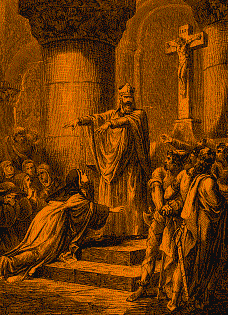The Segondignacs gave their name to History
Former chapel and home to Bordeaux noble families, the Domaine Segondignac is filled with history. It was founded in Bourg Méteuil ( former name of Saint-Germain d’Esteuil) inside the Segondignac property by Clovis.

Origin of the name « Segondignac »
Segondignac means from the second monastery. The first monastery dating back from Clotaire I ‘s era isn’t specified but it can refer to Sainte-Croix or Saint-Seurin.
Sainte Radegonde and the Segondignac property
In the 6th century, Sainte Radegonde, daughter of the king of Thuringe, born in 521, captive and wedded because of her beauty to the king Clotaire I (511-561), son of Clovis and Merovingian king, fled the court to devote herself to religion. She became a Nun in 544 in Noyon (oise) and settled in Poitiers in 546. She had the Poitiers monastery built with the Duke Austrapius and the bishop Pientius’ help. This religious building is the second women’s monastery after Cesaria (in the heart of Saint-Césaire) in Aries. It was first named after the Holy Trinity but it took its name after the Holy Cross, after Sigebert, son of Clotaire I had an eminent Holy Cross relic brought from Constantinople . Clotaire I gave the Segondignac property and its chapel built in honor of Saint Peter to the nuns of the Holy Trinity in Poitiers.

The ancient church of Saint-Germain d’Esteuil
This ancient church of romanesque style was built in 900 under Charles III The Simple’s reign, an ancient carolingian king. The oldest altar in the church was dedicated to Sainte Radegonde to whom a particular cult was dedicated. The ancient church was destroyed and rebuilt in 1895.
Saint-Gaux, a village in Saint-Jean de Segondignac
In ancient registers, the village called Saint-Gaux was always denominated under the name Saint-Jean de Segondignac. The noble bourgeois families from Bordeaux came from the neighborhoods of Burdigala (Roman name for Bordeaux) and Méteuil. The descendants of former soldiers’ families were therefore fervent defenders of the village against the invaders and chose it for a burial ground.
Saint-Jean de Segondignac Chapel
During the 18th century, Saint-Jean de Segondignac Chapel, which was built from the remains of the ancient monastery built under Clovis, was in ruins until 1860. It was transformed into a green pasture where a horse grazed. The priest’s house located 40 meters from there and built along the side of the pasture was called the “Cellier de Segondignac” (Segondignac cellar).




